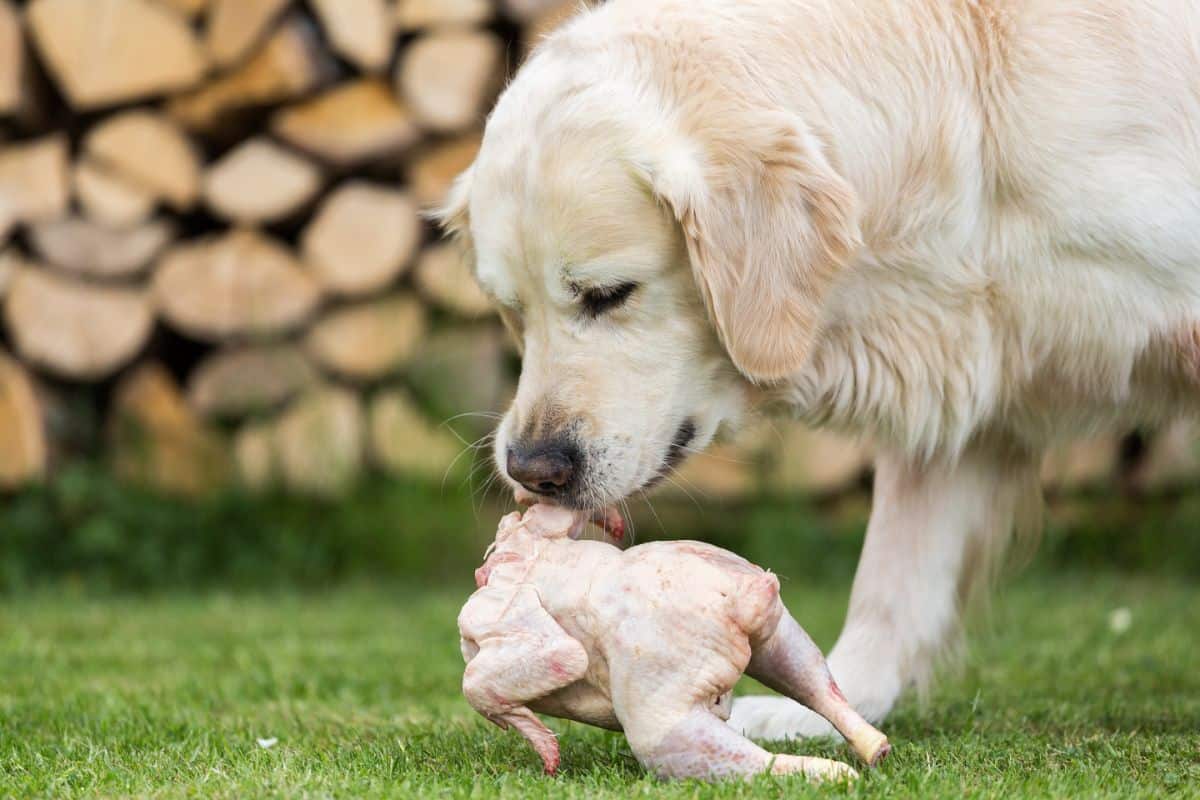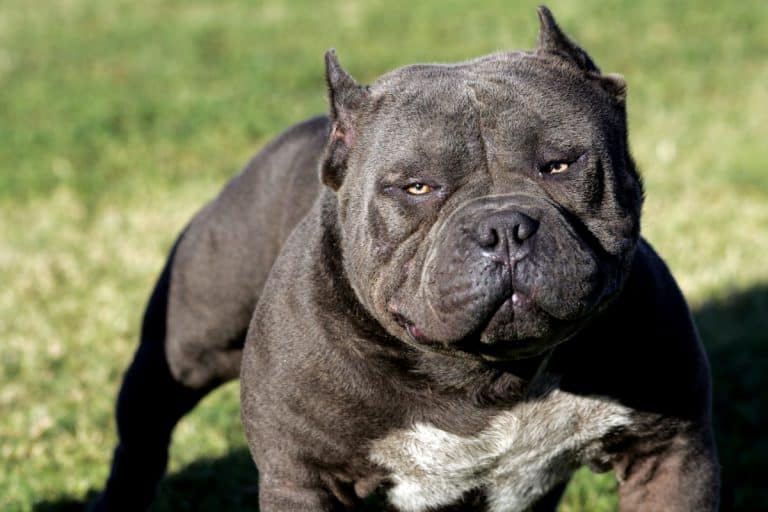My Dog Ate Raw Chicken, Should I Be Worried?
As pet owners will know, dogs have a special knack for eating things they shouldn’t, and raw chicken is no exception.
From scraps of meat which fall onto the floor, to eating out of a grocery bag left on the ground, dogs can come into contact with raw chicken through several ways, and whilst contact is not as dangerous as it is for a human, there are still things you need to be aware of.
The Rise Of Raw Meat
Diet Trends
In recent times, modern diet trends for dogs have seen the incorporation of raw meat and poultry into their diets. Many people do this with good intentions.
Afterall, we have all seen the poor quality of dog food, and we have heard stories about what goes into every tin, and this has led to a rise in pet owners opting for more healthy and natural options for their furry friends.
This has in some ways been bolstered by several internet fitness influencers who claim raw meat lifestyles as the source of their own wellness, and as such the general trend has been on the rise.
But however natural and beneficial raw chicken might seem for your dog, it can come with serious negative consequences that we will explore later on.
Misinformation
Misinformation is also a leading cause of this rising trend.
As dog’s are considered descendents from wolves, who are known for their consumption of raw meat and poultry, many people assume that their digestive systems are suited to this ancestral lifestyle.
However, many factors, including generations of taming and dietary conditioning, have led to dogs developing more sensitive systems, meaning the consumption of raw chicken can cause plenty of health concerns in the long run.
The internet is also to blame for furthering misinformation on this subject, as there are undoubtedly thousands of conflicting sources of information surrounding pet health, written by people who are merely proponents of their chosen diet path, not experts in animal nutrition and health.
Is Raw Chicken Safe For Dogs?

Whilst your dog may fare better than you when it comes to consuming raw chicken, there is still the risk of health troubles as a result.
That isn’t to say that one bite will hurt them, and of course some dogs are more resilient than others, but prolonged consumption of raw poultry does leave them at risk for the same dangers of bacteria and illness as we are.
The thing to remember is that it is neither totally dangerous, nor totally safe, and as such comes with a loaded risk factor that responsible pet owners shouldn’t roll the dice on.
What Are The Risks?
Whilst proponents of the dietary choice focus on the benefits of raw chicken, the risks cannot be ignored.
There are three main problem areas associated with dogs consuming raw chicken, all of them potentially serious, especially if exposed to on a regular basis, and these are salmonella, malnutrition, and choking risks.
Salmonella Poisoning
This is perhaps one of the most associated risks of consuming raw chicken, and an illness that somewhat acts as a phantom surrounding human consumption of the poultry.
Salmonella is the most common form of food poisoning, and is especially present and virulent on meat which has been uncooked or undercooked.
The bacteria can primarily be found in the intestines of certain animals, as well as in amongst the feces, and when a pet owner handles raw chicken (even just for their own preparation and consumption), the risk of transferring the bacteria to their pet are drastically increased if proper measures are not taken.
Symptoms of salmonellosis can include vomiting, diarrhea, reduced appetite, lethargy and fatigue, and a high fever, making it very dangerous both for you and your pet.
The main way to avoid salmonella in your pet is to only give them cooked poultry, which you have probed to ensure is at the right temperature before serving.
The second way is to establish a work surface and chopping board that is reserved just for the preparation of raw chicken, as well as a specified knife.
Then, when preparation of the chicken is complete, make sure you clean the knife, the board, the work space, and your hands.
The latter is perhaps most important of all, as it reduces the risk of infection through contact with your face or mouth, or your dog’s bowl or toys.
Treatment options for this include antibiotics and IV treatment to replenish fluids, and ignoring the infection can prove fatal for your pet, especially if they have a sensitive immune system or dysbiosis of the gut.
Campylobacter
This is especially prominent in poultry, and is a bacterial infection that can cause food poisoning in humans, and abortions in pregnant dogs.
The bacteria appears in the feces of chickens, turkeys, geese, and ducks, and can cause a gastronomical infection called campylobacteriosis, which is characterized by bloody diarrhea and dysentery syndrome, consisting of cramps, fever and pain.
This is especially important to bear in mind if you are feeding raw chicken to a pregnant dog, and should also be a concern to you as the server too, as it has been linked to jejunum, ileum, and colon tissue damage.
Malnutrition
Malnutrition only really refers to a consistent diet of raw chicken, as this does not make up a balanced, healthy diet for your dog.
Dogs, just like humans, require a balanced regime of vitamins and minerals for maximum health and nutrition, and lack of this can lead to weakened immune systems, fragile bones and teeth, organ issues, and lowered energy levels.
This can also have worse effects further down the line too, with the weakened immune system especially leading to further illness and infections if not corrected.
The best method for ensuring the long term health of your dog is to provide them with a balanced and nutritious diet of protein, mega fatty acids, carbohydrates, vitamin C, water, and healthy minerals, such as magnesium, calcium, and phosphorus.
Choking Risks
With chicken (raw or cooked) there is also the added risk of your dog choking on unseen bones and gristle, which can prove fatal if not quickly helped.
Chicken bones can get stuck in the mouth, teeth, and throat, can cause obstructions in the intestinal tract and stomach, and could even puncture internal organs if unfortunate enough.
This is why it is important to serve smaller cuts of cooked chicken to your dog, so you can ascertain whether there are bones hidden in the meat or not. That way you can rest easy knowing that your dog is safe and healthy.
Habitual Vs Accidental
Of course, an important distinction needs to be made surrounding the how and why your dog might have eaten raw chicken.
Habitual
If it is a habitual part of their daily diet, then your dog stands a much larger chance of experiencing some of the illnesses or accidents associated with raw chicken.
This is just down to plain statistical probability, as the more times you serve a potentially dangerous dish, the higher the chance of suffering negative effects.
Accidental
If however your dog simply scooped some raw chicken off of the floor during food preparation, then it is highly unlikely anything serious will befall them.
Largely due to the smaller quantity they will have likely consumed, as well as the lack of regularity and high exposure, this shouldn’t be a problem for your dog.
However, still be mindful of this, and keep a close eye on your dog, checking for any of the associated symptoms discussed in the previous section, and seek medical attention from a registered veterinary surgeon if anything should arise.
Are There Any Benefits?
Despite the negatives, raw chicken still remains a popular choice served to dogs by their owners. But what, if any, are the benefits of this diet choice?
Nutritional
The main benefit of raw chicken is that it is around 80% protein, meaning it is a good source, despite the risks.
There are also no carbohydrates or sugars in fresh, raw chicken, which means you know exactly what your dog is eating.
Raw chicken is also a source of magnesium, phosphorus, potassium, vitamin B12 and other beneficial nutrients, however there are better, safer sources out there to try.
Allergens
Of course, another reason is that it is devoid of any hidden allergens which might cause problems for particularly sensitive dogs, or for those with specific dietary requirements.
This alleviates a lot of the worries surrounding hidden ingredients in dog food and other such items, but there are simpler and safer ways to achieve such peace of mind. Even simply cooking it improves the safety of this dietary choice.
Price
Chicken is also incredibly inexpensive to buy, at a time when meat prices (as well as everything else) is on the rise. This makes it a popular choice for pet owners looking for nutritional value on a tight budget.
Safe Food Preparation Methods
If you are adamant that this is the right choice for your dog, then it is important to take various measures to ensure the safety of your pet.
Firstly, if you can afford it, try to buy organic chicken. This is a more costly option, but is generally of better quality than standard options.
It is also important to make sure all chicken is properly stored, isn’t left out on the kitchen counter to get warm, and has been properly sealed. If this isn’t the case, there might be a higher chance of bacterial contamination.
Once again, ensure kitchen cleanliness, especially before, during and after raw chicken preparation, and also clean your dog’s bowl and eating area thoroughly for added safety.
Remember also that it is better to serve it plain, without any seasoning or spices that might upset your dog’s stomach, or make them sick.
Finally, it is important to monitor your dog after eating, making sure there are no signs of diarrhea or vomiting, and that they are generally in good health. This is simple, and can become part of the meal routine.
Things To Remember
Ultimately, there are several things that need to be considered before making this choice.
Firstly, simply cooking the chicken is a far safer option for your pet than serving it raw. Whilst some of the nutritional value may be lost during the cooking process, this can be supplemented with vitamins, other mineral sources, or as part of a balanced diet, and the extra work easily cancels out the potential risks.
Also, it is important to remember that there are plenty of options out there that are safer and equally as nutritious.
Beef, for example, can be safely served raw, and is a high source of protein and nutrients. Whilst this may generally be pricier, there are cheaper or less desirable cuts available, which provide the same benefits at a reduced cost.
The best thing to do for optimal pet health is create a food regimen, just like you would if you were trying to get in better physical and nutritional shape.
Make it balanced, and ensure all of the above mentioned minerals and vitamins are present and accounted for.
Finally, a good piece of advice is to avoid fad diets and internet trends. These tend to be fleeting, easily disproved (or unbacked by science), and can prove more costly and harmful in the long run.
Stick to tried and tested methods to ensure optimum pet health, and leave the trends to the influencers.
Final Thoughts
And there we have it, everything you need to know about the health and safety information surrounding raw chicken consumption in dogs.
The best things to remember are to balance their diet, maintain a clean and safe cooking environment (especially where raw chicken is concerned), and focus on variety and tried methods that are proven to be healthy, beneficial, and most importantly safe.






